Counterpressing, a translation of the German word “gegenpress”, is a team’s immediate attempt to regain possession in the aftermath of losing the ball. One of the leading proponents of the gegenpress over the last decade has been Liverpool and former Borussia Dortmund manager Jurgen Klopp. This season, it has been Tottenham Hotspur under Ange Postecoglou catching people’s eye with their counterpress intensity and clinical nature.
The tactical theory can be defined as the act of regaining possession before the opposition can gain comfortable possession. Thus forcing the opposition to play on the edge of their abilities and limiting the team’s time without the ball. Whilst counterpressing can occur anywhere on the pitch, this analysis is going to focus on counterpressing in the final third.
As this tactical theory will analyse, counterpressing requires a quick reaction by players to lose the ball and for them to be optimally positioned before losing the ball. This tactical analysis will analyse Postecoglou’s counterpress tactic at Celtic and Spurs. It will analyse Postecoglou’s attacking structure and key trends to his counterpress. This analysis will offer suggestions on how coaches can implement this high-intensity style of play.
Rest-defense
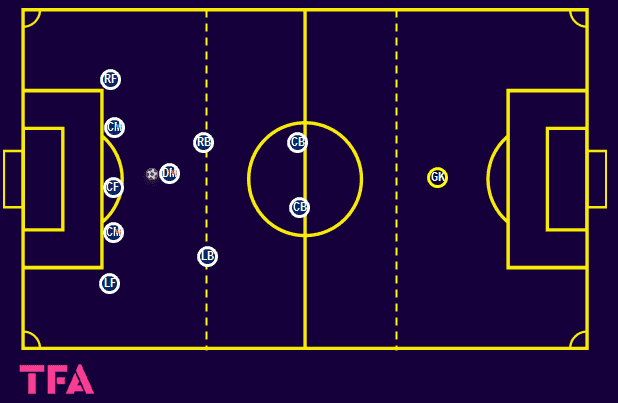
Postecoglou’s teams live and die by their counterpress. The plan is to win the ball back as quickly and as close to the opposition’s goal as possible. When the ball is regained, the next critical step is to release a shot at goal as soon as possible. The rewards of an excellent counterpressing structure are two-fold. One, it creates another goalscoring opportunity, often when the opposition is off balance. Secondly, it keeps the ball far from your own goal and prevents the in-possession team from building out comfortably and finding their rhythm.
The critical part of this theory is a team’s “rest-defense”. That is, the positioning of their players whilst they are launching an attack with the ball. If a team is too spread out whilst attacking, they are vulnerable to counterattacks. If they do not have enough players around the ball, pressing an opposition player effectively when the ball is lost is impossible.
The above tactical diagram shows the general positioning of Postecoglou’s Spurs players whilst attacking in the final third this season. In addition to the speed and quality of his team play, two elements of his game model stand out in these scenarios. One is the vast number of players he commits to attacking the box ahead of the ball. The other is the relatively high positioning of the players behind the ball, providing defensive security.
The players providing this defensive security are typically the full-backs who have become inverted. Having these narrow full-backs and aiding the counterpress forces teams to play wide on transitions. This prevents the opposition from being able to slice them straight through the middle.

The above image and tactical diagram is from early in Postecoglou’s reign as Celtic manager. Celtic are attacking the box with five players ahead of the ball. Just out of shot (shown on the tactical diagram) and behind the ball carrier, Celtic’s full-backs are both inverted within the width of the box. Just before receiving the ball, the defensive midfielder was between the full-backs. This created a line of three, centrally, on the edge of the attacking third.
By having so many players in advanced positions, the opposition is forced to bring more players behind the ball. This makes it harder for them to escape as they are pinned in defensive positions. With only one Hearts player in an advanced position, Celtic can predict who Hearts will play forward to. This makes it easier for them to set up and nullify this player. This not only pins Hearts, but if any player receives or intercepts the ball, there will be a Celtic player close enough to immediately counterpress.
To underline Postecoglou’s commitment to his style of play and his “we never stop” mentality, this scenario occurred with Celtic leading by a single goal in injury time. Other managers may be reluctant to have so many bodies in the final third, especially in what was such a pivotal time for Postecoglou at Celtic. However brave this system may appear, it kept the opposition pinned in their own third and the ball far from the Celtic goal.
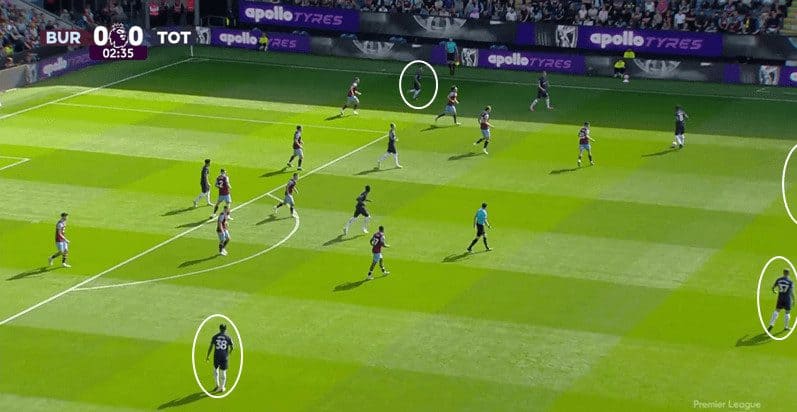
The above image is from Spurs’ match against Burnley earlier this season; Burnley did not leave a forward high when Spurs were attacking. This meant that both their circled full-backs could attack higher and wider, with their centre-backs taking their place in the middle of the pitch.
In this example, left back, #38 Destiny Udogie, had attacked down the left wide area. He then moved slightly more centrally when the ball was switched to the right. This set-up allowed Spurs to attack with seven players ahead of the ball. As with the previous example, the sheer volume of players in the final third means Spurs can win the ball straight back should they lose it.
Reaction to loss of possession
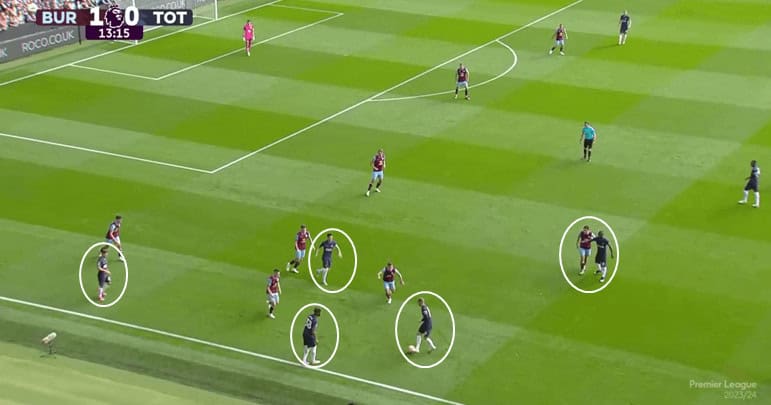
This phase of play against Burnley encapsulates many aspects of Spurs’ counterpressing principles. When the ball is played wide, Spurs overload that area of the pitch, taking up positions that almost mimic a rondo. This is designed to draw defending players into the wide area to exploit another area of the pitch. From a counterpressing point of view, it allows Spurs to combine with each other securely. They will have a player near the ball to press it if they lose it. #8 Yves Bissouma, to the right of the image, is almost marking the Burnley player who would be their preferred out-ball should they win the ball.
In this scenario, James Maddison feeds a through ball to his winger that is intercepted by the Burnley full-back. Due to the close proximity and immediate reaction of Spurs’s winger, they win it back straight away. This leads to the winger bursting into the box to provide a cut-back.
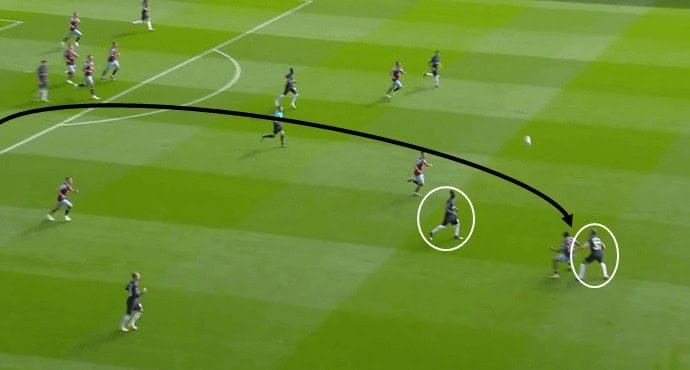
The winger’s cut-back is blocked and deflects to a Burnley player. With so many players in and around the box, Spurs again apply heavy pressure to the receiving Burnley player. The defender is forced to rush his clearance. He volleyed long and high over his shoulder towards his striker, who, on this occasion, has remained high during Spurs’ attack.
The ball-near centre-back was positioned touch-tight to the lone forward with his defensive team-mate covering behind. The centre-back, being right up against the forward, physically prevented the forward from spinning in behind, had that been an option for him. With the forward unable to control the ball due to the close attention of the defender, the Spurs’ midfielder doubled up and won the loose second ball.
This is a common aspect of the Spurs’ reaction to long or aerial balls. Whenever one of their players goes up to compete for a header, at least one player, often more, gets within five yards of the ball. This allows them to pick up the second ball even when the initial aerial dual is lost.
This attack shows the sheer intensity of Postecoglou’s team’s play. In 10 seconds, Spurs have lost the ball twice and won it back before the opposition could complete two passes. Not only does this make it difficult for the opposition to play, but it also frees up his own players. If the players know when they lose the ball, they win it back quickly; they can risk losing the ball to attempt decisive passes.
Training session
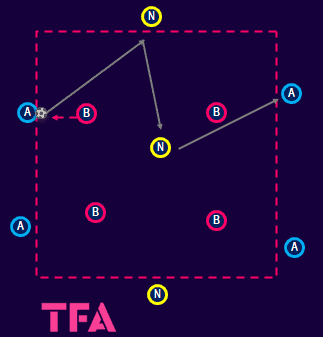
Training sessions must be designed to replicate the positioning and reactions required of the players in matches to implement this style of play. Postecoglou is renowned for his intense training sessions, which are necessary to prepare players to perform an effective counterpress.
Rondo’s are a popular choice of coaches working on transitions. They can replicate game-like scenarios where, just as in the Spurs wide area example, players combine in tight triangles and react to losing the ball. Rondos and the number of players involved in the counterpress can get progressively larger in both areas. This allows the coach to gradually increase the load on the players as the session develops. This is especially important when working on counterpressing as it involves a lot of maximum effort sprints.
This example, rondo creates a 7 Vs 4 with two teams of four playing with the three neutral players when they have the ball. The four players on the in-possession team (shown as blue) are placed two and two on opposite sides of the box. The neutral team (yellow) occupy the other two sides, with another being a link-up player in the middle, free to move around the box. The defending team (pink) presses the seven attacking players.
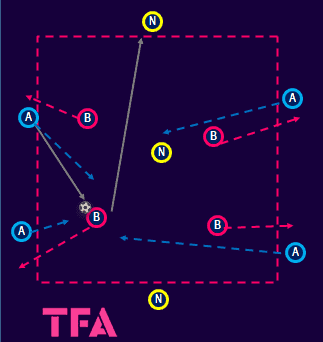
Should the pink team win the ball, they transition by finding a neutral player while moving to their positions on the outside of the box. The blues, who have just lost possession, counterpress with the aim of winning the ball back before the pinks can take up their positions.
Just as in a game, the first few seconds are vital. If the pink are allowed to play their first few passes and given the time to take up their positions, they can get in a rhythm. This will enable them comfortable possession and make them much more challenging to dispossess. Players should be reminded that whilst sprinting can be taxing, they will run a lot more if they do not get the ball back quickly.
The size of the box should be set depending on the level of the players. The aim should be for the in-possession team to connect a good number of passes. This prevents the rondo from being turned into one constant transition.
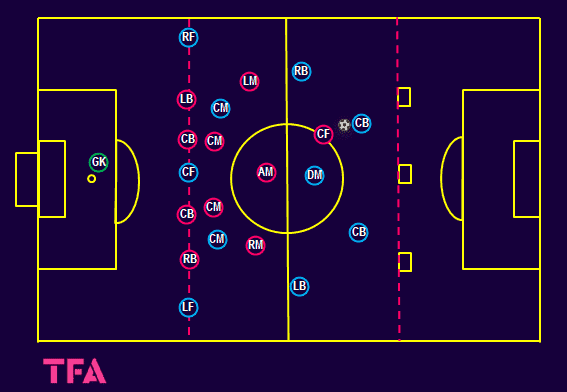
After a series of progressive rondos or possession games, the session can advance to a full, or close to full, 11 Vs 11. This zone game set-up is designed to work on the player’s rest defence whilst they are attacking. The ball starts with the working team, the blue’s, who start the play in their own half. They attempt to work the ball to score into the big goal.
The defending team, pink, defend as they would in a real game. If they regain possession, their aim is to score into any one of the three centrally positioned small goals.
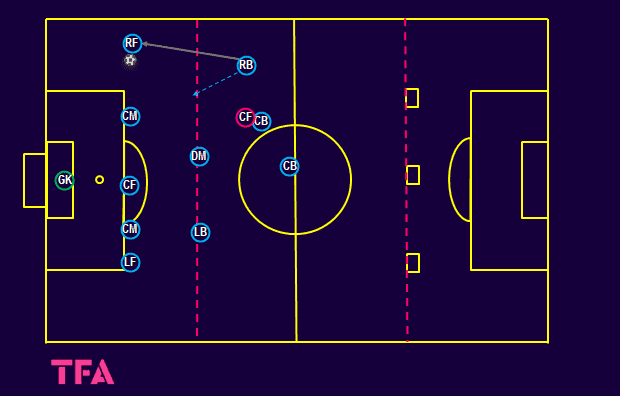
When the ball enters the final third, crossing the pink line, the forwards, midfielders and full-backs cannot retreat back over the line. This encourages the forwards to attack the box in numbers. It also forces the midfielders and full-backs to be close enough to support the ball and be in positions to counterpress.
The players should be coached on specific positions to take up. Based on Postecoglou’s teams, the full-backs should narrow to central positions and be on the edge of the attacking third. Assuming the forward is on that side, the ball-near centre-back should be touch-tight to the forward whilst the ball-far centre-back covers behind.
If the blue team loses possession in the final third, the defensive midfielder and full-backs should be encouraged to press immediately. If they are in the proximity of the ball, they should sprint forward rather than retreat. If their positioning is correct, the opposition, if able to evade the counterpress, will still have to play to the outside.
Conclusion
For any effective counterpressing team, players must be positioned to win the ball back while their team is in possession. If done well, counterpressing can be used to create goalscoring opportunities and keep the ball far from your own goal.
Counterpressing well can also free players up mentally, knowing they can take chances with the ball because they are likely to win it straight back again. It is also mentally draining on opposition teams, especially for teams playing against Postecoglou’s teams, who go long periods without the ball. Wining it back before losing it again straight away is frustrating and mentally exhausting.






Comments